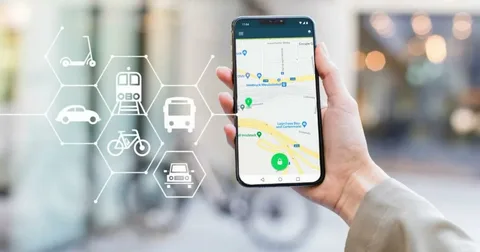Austin, Texas—a city known for its tech-savvy culture, vibrant startup ecosystem, and progressive adoption of digital trends—is quickly becoming the heart of innovation in mobile app development. As the demand for smart, secure, and efficient urban transportation grows, taxi services are undergoing a significant digital transformation. At the forefront of this shift is a groundbreaking advancement: the integration of facial recognition technology into taxi apps.
From enhancing passenger safety to improving driver authentication, facial recognition apps are setting a new benchmark in ride-hailing services. In this blog, we explore how Austin-based mobile developers are revolutionizing the taxi industry, what makes a great Taxi App Development Company, and how facial recognition is shaping the future of urban mobility.
The Evolution of Taxi Apps: From Convenience to Intelligence
The taxi industry has seen massive digital disruption in the last decade. With the rise of ride-hailing giants like Uber and Lyft, traditional taxi companies were forced to innovate or become obsolete. Mobile apps offered a fast, cashless, and GPS-tracked experience that passengers quickly adopted.
However, as ride-hailing became mainstream, new challenges emerged—passenger safety, identity fraud, driver misrepresentation, and even vehicle theft. Enter facial recognition apps—AI-driven technologies designed to authenticate identity using biometric data.
Why Austin?
Austin isn’t just the capital of Texas—it’s the capital of innovation. With a rich ecosystem of software startups, tech universities, and creative professionals, the city has become a breeding ground for next-generation solutions. It’s no surprise that a leading Taxi App Development Company has set up shop in Austin, catering to clients seeking advanced, AI-powered taxi platforms.
Facial Recognition Apps: A Game-Changer in Taxi Services
Facial recognition apps use artificial intelligence and computer vision to identify individuals based on facial features. This technology is already in use across airports, banking apps, and even smartphones. When applied to taxi services, it adds a critical layer of security and personalization.
Key Features of Facial Recognition Integration in Taxi Apps:
- Driver Verification: Before starting their shift, drivers can undergo real-time facial authentication to ensure that only authorized personnel are operating the vehicle.
- Passenger Identity Matching: For registered users, the app can verify the identity of the passenger upon pickup—reducing the risk of ride-hijacking or fraud.
- Touchless Login: Users can access their accounts through facial scans, eliminating the need for passwords or OTPs.
- Incident Prevention & Tracking: In case of suspicious activity, the system can use facial data to flag, report, or even deny access automatically.
- Child & Elderly Safety: Families booking taxis for children or elderly members can ensure the right person is picked up and dropped off securely.
These functionalities not only make the app more secure but also position it as a trustworthy solution in an industry that heavily relies on public interaction.
Austin’s Leading Taxi App Development Companies Driving Innovation
Several Taxi App Development Companies based in Austin are at the forefront of this technological revolution. These companies are merging AI with UX, creating seamless and intelligent applications that cater to both end-users and operators.
What Sets Austin Developers Apart?
- AI-Centric Development: Unlike generic developers, Austin’s app teams prioritize smart algorithms, real-time data processing, and biometric authentication to create standout apps.
- Custom Mobility Solutions: Whether it’s a city-run taxi fleet, a private transportation startup, or an enterprise mobility service, Austin developers provide custom app architecture tailored to unique business goals.
- Data Security & Compliance: With increasing concern over biometric data privacy, developers in Austin are ensuring compliance with state and federal data protection laws such as CCPA and GDPR.
- User-Centric Design: Despite high-tech features, the UX/UI of these taxi apps remains intuitive and user-friendly—a testament to the design-first mindset of Austin’s tech community.
Real-World Use Cases of Facial Recognition in Taxi Apps
1. SafeCommute—An Austin Pilot Project
A collaborative initiative between the local government and a leading Taxi App Development Company, SafeCommute has integrated facial recognition to authenticate both drivers and passengers. The system reduced cases of driver impersonation by 65% within three months.
2. BizRide—Corporate Taxi App
This facial recognition app was designed specifically for business travelers and employees commuting in company-sponsored rides. It ensured that only approved individuals could access the service, protecting both the driver and rider.
3. ParentTrack
This Austin-based app allows parents to track rides for their children and elderly family members. Using facial verification, the app confirms both pick-up and drop-off identities, offering unmatched peace of mind.
Benefits of Facial Recognition in Taxi Apps
Here’s how facial recognition is reshaping mobility experiences:
1. Enhanced Security
Facial recognition apps drastically reduce identity fraud, unauthorized access, and criminal impersonation—making rides safer for both drivers and passengers.
2. Operational Efficiency
Taxi companies save time and resources through automated identity checks, removing the need for manual verification or paperwork.
3. User Trust and Brand Loyalty
With passengers feeling more secure, taxi apps that integrate facial recognition see higher retention rates, more positive reviews, and increased brand loyalty.
4. Competitive Advantage
In a saturated ride-hailing market, smart taxi apps with biometric features give businesses a critical edge.
Challenges and Ethical Concerns
As with any technology, facial recognition comes with challenges that developers and businesses must address:
1. Privacy Issues
Biometric data is sensitive. Storing and using facial data raises questions about surveillance, consent, and misuse.
Solution: Austin developers are embedding end-to-end encryption and secure cloud architecture, along with clear consent protocols.
2. False Positives/Negatives
In rare cases, the system may misidentify users due to lighting, facial changes, or camera quality.
Solution: Developers are integrating fallback authentication methods such as PINs, voice recognition, or manual verification.
3. Cost of Implementation
Facial recognition requires advanced AI models and hardware-compatible software, increasing initial development costs.
Solution: Taxi App Development Companies in Austin offer scalable pricing models and modular app builds to make the integration affordable.
The Road Ahead: What’s Next for Smart Taxi Apps?
The future is bright—and incredibly smart. As 5G becomes widespread and edge computing grows, facial recognition will be just one layer of multi-dimensional taxi apps. Here’s what lies ahead:
1. Emotion Recognition
Future apps may detect emotions like stress or discomfort, and adjust routes, music, or even notify emergency contacts.
2. Voice Biometrics
Combined with facial recognition, voice authentication can create an even more secure, multi-layered identity system.
3. AR Navigation for Drivers
Facial recognition can work in sync with Augmented Reality (AR) to guide drivers using face-based passenger location tracking.
4. Smart Contracts for Payments
Blockchain-based payments integrated with identity verification via facial recognition can automate secure transactions between riders and fleet owners.
How to Choose the Right Taxi App Development Company in Austin
Looking to build a smart taxi app with facial recognition features? Here are some key criteria to consider:
- Portfolio & Experience: Choose a company that has experience in developing taxi or mobility-related apps with AI features.
- Security Expertise: Ensure they prioritize biometric data security and compliance.
- Scalability: Look for a team that can help you scale from pilot to enterprise level.
- End-to-End Services: From wireframes to testing to post-launch support—opt for a full-cycle development partner.
- Client Testimonials: Check reviews or case studies for insights into their development process and customer satisfaction.
Final Thoughts: The Fusion of AI and Mobility in Austin
As Austin continues to assert itself as a tech powerhouse, the fusion of AI with transportation is not just a trend—it’s a necessity. Facial recognition apps are empowering taxi companies to offer safer, smarter, and more personalized experiences. Whether you’re a startup or an established transport operator, investing in a taxi app with biometric capabilities is a step toward future-proofing your business.

